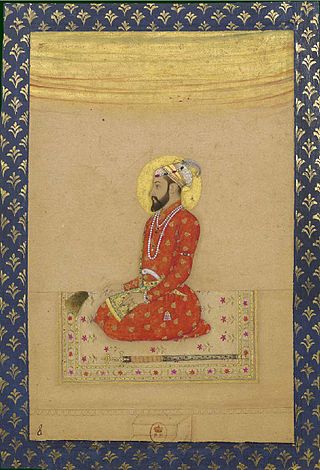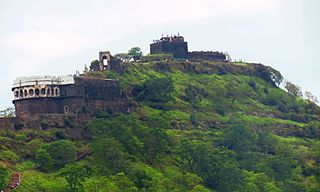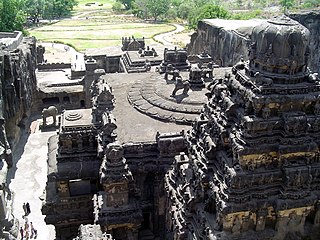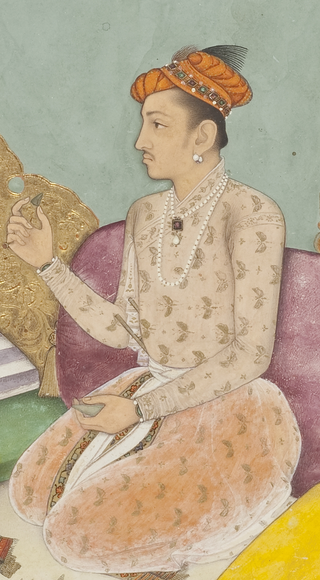
Mirza Shahab-ud-Din Muhammad Khurram, also known as Shah Jahan I, was the fifth Mughal Emperor, reigning from 1628 until 1658. Under his emperorship, the Mughals reached the peak of their architectural achievements and cultural glory.

Mirza Muhammad Mu'azzam, commonly known as Bahadur Shah I and Shah Alam I, was the eighth Mughal emperor from 1707 to 1712. He was the second son of Mughal emperor Aurangzeb, who he conspired to overthrow in his youth. He was also governor of Agra, Kabul and Lahore and had to face revolts of Rajputs and Sikhs.

The Lahore Fort is a citadel in the city of Lahore in Punjab, Pakistan. The fortress is located at the northern end of Walled city of Lahore and spreads over an area greater than 20 hectares. It contains 21 notable monuments, some of which date to the era of Emperor Akbar. The Lahore Fort is notable for having been almost entirely rebuilt in the 17th century, when the Mughal Empire was at the height of its splendor and opulence.

DaulatabadFort originally DeogiriFort, is a historic fortified citadel located in Daulatabad village near Aurangabad, Maharashtra, India. It was the capital of the Yadavas, for a brief time the capital of the Delhi Sultanate, and later a secondary capital of the Ahmadnagar Sultanate.

Mughal architecture is the type of Indo-Islamic architecture developed by the Mughals in the 16th, 17th and 18th centuries throughout the ever-changing extent of their empire in the Indian subcontinent. It developed from the architectural styles of earlier Muslim dynasties in India and from Iranian and Central Asian architectural traditions, particularly Timurid architecture. It also further incorporated and syncretized influences from wider Indian architecture, especially during the reign of Akbar. Mughal buildings have a uniform pattern of structure and character, including large bulbous domes, slender minarets at the corners, massive halls, large vaulted gateways, and delicate ornamentation; examples of the style can be found in modern-day Afghanistan, Bangladesh, India and Pakistan.

Aurangabad district, officially known as Chhatrapati Sambhaji Nagar district, is one of the 36 districts of the state of Maharashtra in western India. It borders the districts of Nashik to the west, Jalgaon to the north, Jalna to the east, and Ahmednagar to the south. The city of Aurangabad houses the district's administrative headquarters. The district has an area of 10,100 km2, of which 37.55% is urban and the rest is rural. Aurangabad District is a major tourism region in Marathwada.

The Mughal dynasty comprised the members of the imperial House of Babur (Persian: خاندانِ آلِ بابُر; Khāndān-e-Āl-e-Bābur), also known as the Gurkanis, who ruled the Mughal Empire from c. 1526 to 1857.

Nashik district, also known as Nasik district, is a district in Maharashtra, India. The city of Nashik is the administrative headquarters of the district. Nashik is well known for the production of wine. Nashik is also known as Mini Maharashtra, because the climate and soil conditions of Surgana, Peth, Igatpuri resembles with Konkan. Niphad, Sinnar, Dindori, Baglan blocks are like Western Maharashtra and Yeola, Nandgaon, Chandwad blocks are like Vidarbha Region. Nashik is the biggest city in the district while Malegaon is the second biggest city. Manmad, Igatpuri, and Sinnar are some of the big cities situated in the Nashik District. Manmad is one of the biggest railway junctions in India while the city of Malegaon is famous for its powerloom.

The Vakataka dynasty was an ancient Indian dynasty that originated from the Deccan in the mid-3rd century CE. Their state is believed to have extended from the southern edges of Malwa and Gujarat in the north to the Tungabhadra River in the south as well as from the Arabian Sea in the west to the edges of Chhattisgarh in the east. They were the most important successors of the Satavahanas in the Deccan and contemporaneous with the Guptas in northern India.

Delhi has been an important political centre of India as the capital of several empires. The recorded history of Delhi begins with the 8th century Tomar Rajputs kingdom. It is considered to be a city built, destroyed and rebuilt several times, as outsiders who successfully invaded the Indian subcontinent would ransack the existing capital city in Delhi, and those who came to conquer and stay would be so impressed by the city's strategic location as to make it their capital and rebuild it in their own way.

Mirza Muhammad Akbar was a Mughal prince and the fourth son of Emperor Aurangzeb and his chief consort Dilras Banu Begum. He went into exile in Safavid Persia after a failed rebellion against his father in the Deccan.

Mirza Raja Jai Singh I was the senior most general and a high ranking mansabdar at the imperial court of Mughal Empire as well as the Kachwaha ruler of the Kingdom of Amber. His predecessor was his grand uncle, Mirza Raja Bhau Singh,the younger son of Mirza Raja Man Singh I

Udai Singh, often referred as the Fat was the Rathore ruler of Marwar, which was later known as Jodhpur. He was also the maternal grandfather of Shah Jahan, the fifth Mughal Emperor, and an ancestor of all subsequent emperors.

Narnala Fort or Narnala Qila Sarkar, also known as Shahnoor Fort, is a hill fortress in the Satpura Range of Vidarbh, Maharashtra, India, named after the Rajput Solanki Chaulukya Ruler, Raja Narnal Singh, also known as Narnal Singh Swami. It was renamed as "Shahnoor" by Islamic rulers but again acquired, rebuilt and got its name "Narnala" by ruler Rao Rana Narnal Singh Solanki, who migrated from Patan in Gujarat.
The Mughal–Rajput Wars were a series of battles fought between the Rajput Confederacy and the Mughal Empire which started with the Timurid ruler Babur's invasion of northwestern India and the head of the Rajput confederacy Rana Sanga's resistance to it.

Maharashtra state in India is known for its Famous caves and cliffs. It is said that the varieties found in Maharashtra are wider than the caves and rock-cut architecture found in the rock cut areas of Egypt, Assyria, Persia and Greece. The Buddhist monks first started these caves in the 2nd century BC, in search of serene and peaceful environment for meditation, and they found these caves on the hillsides.

The Ghatotkach Caves are located 18 km to the west of Ajantha, near Jinjala village, India. The caves include three Buddhist caves, one is a chaitya and two are viharas. The caves were excavated in the 6th century AD, and were influenced by Mahayana Buddhism.

Tourism in Marathwada refers to tourism in the Marathwada region of Maharashtra state in India. Aurangabad is a regional headquarters in Marathwada, and the tourism capital of Maharashtra state. Out of the four UNESCO World Heritage Sites in Maharashtra, two are in the Marathwada region. There are also 110 monuments in Marathwada which are protected by Government of Maharashtra and recognized by Archaeological Survey of India.
The Architecture of Delhi dates back more than a thousand years. As the capital of several great empires of India, including Rajput kingdom, Delhi Sultanate, Mughal Empire, and British Raj, the city of Delhi has been a centre for art and architecture.


















